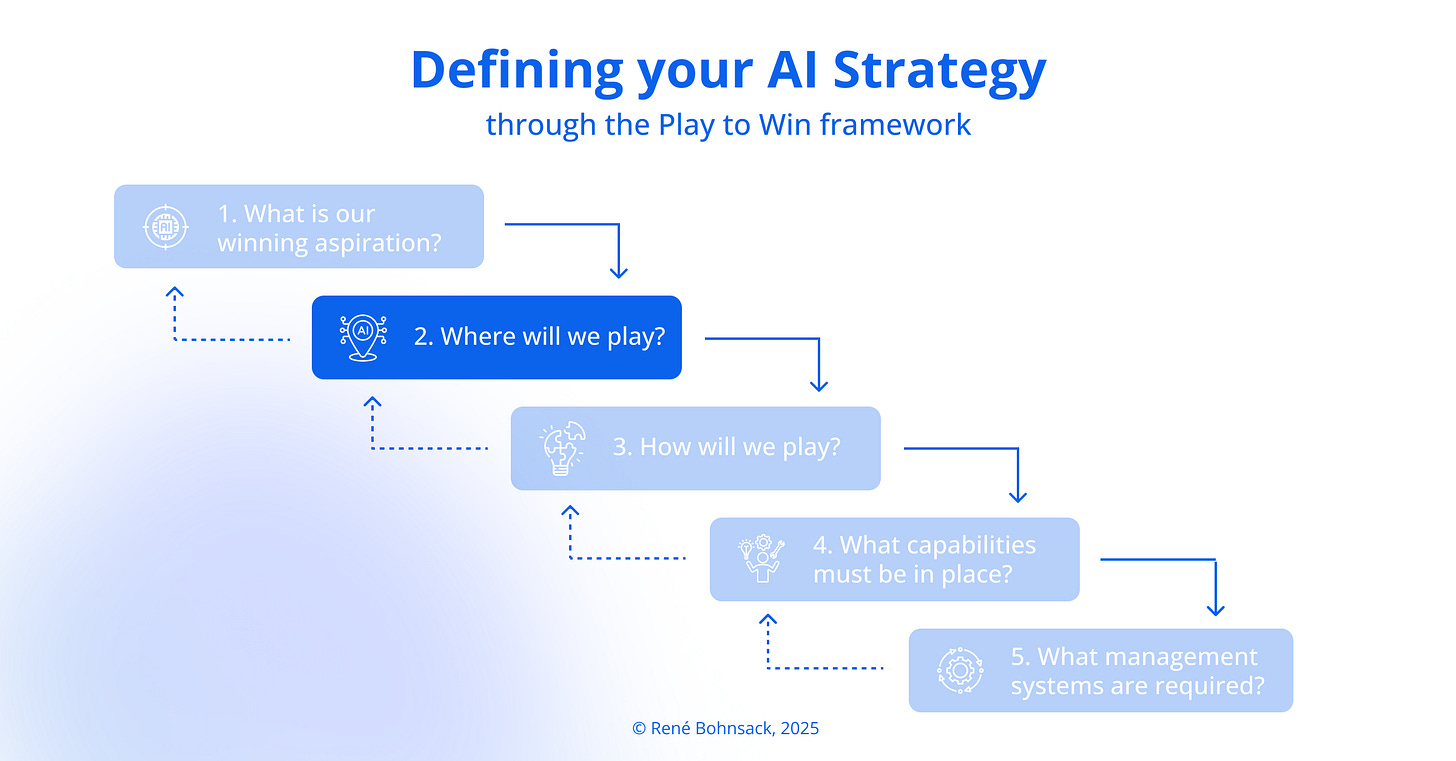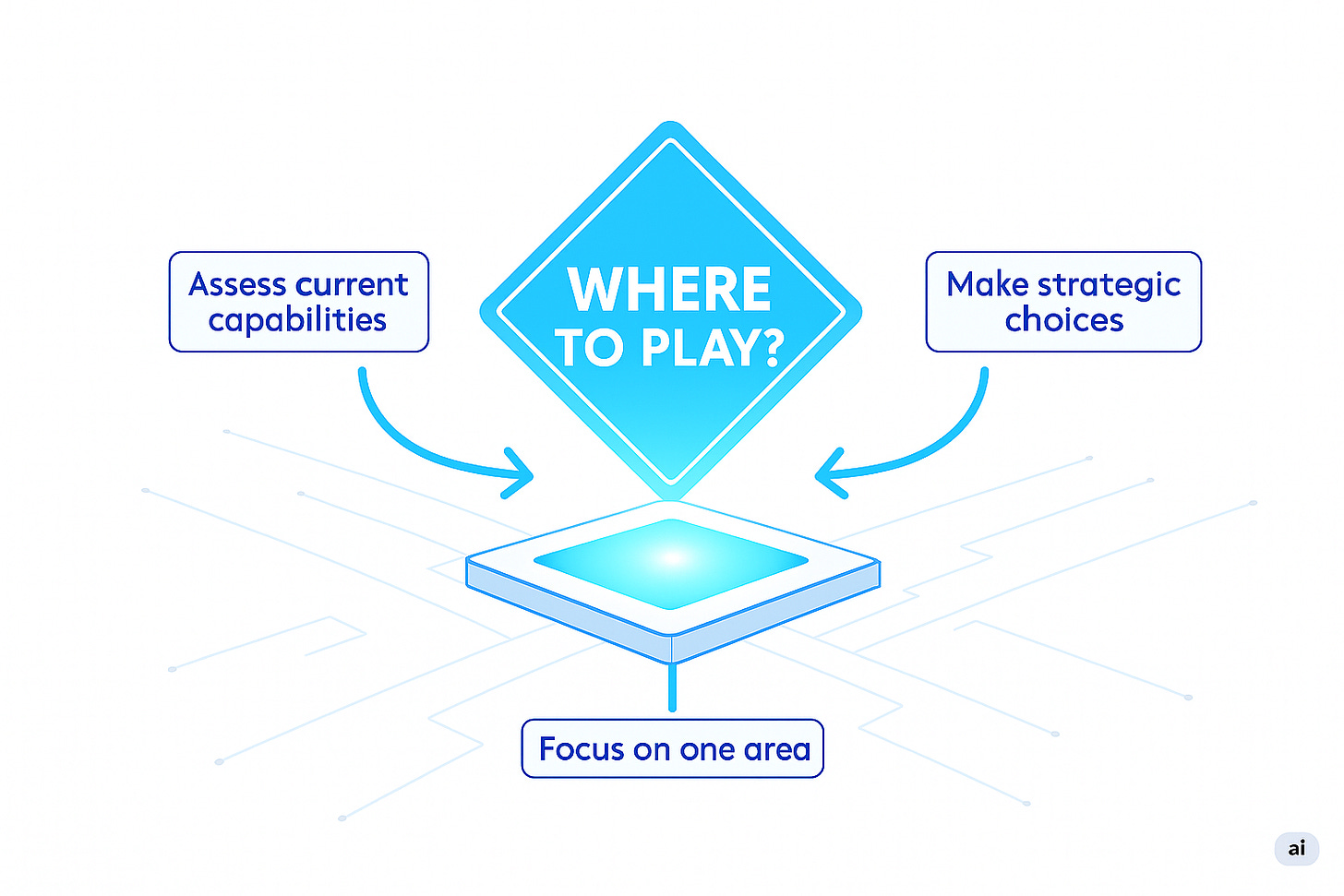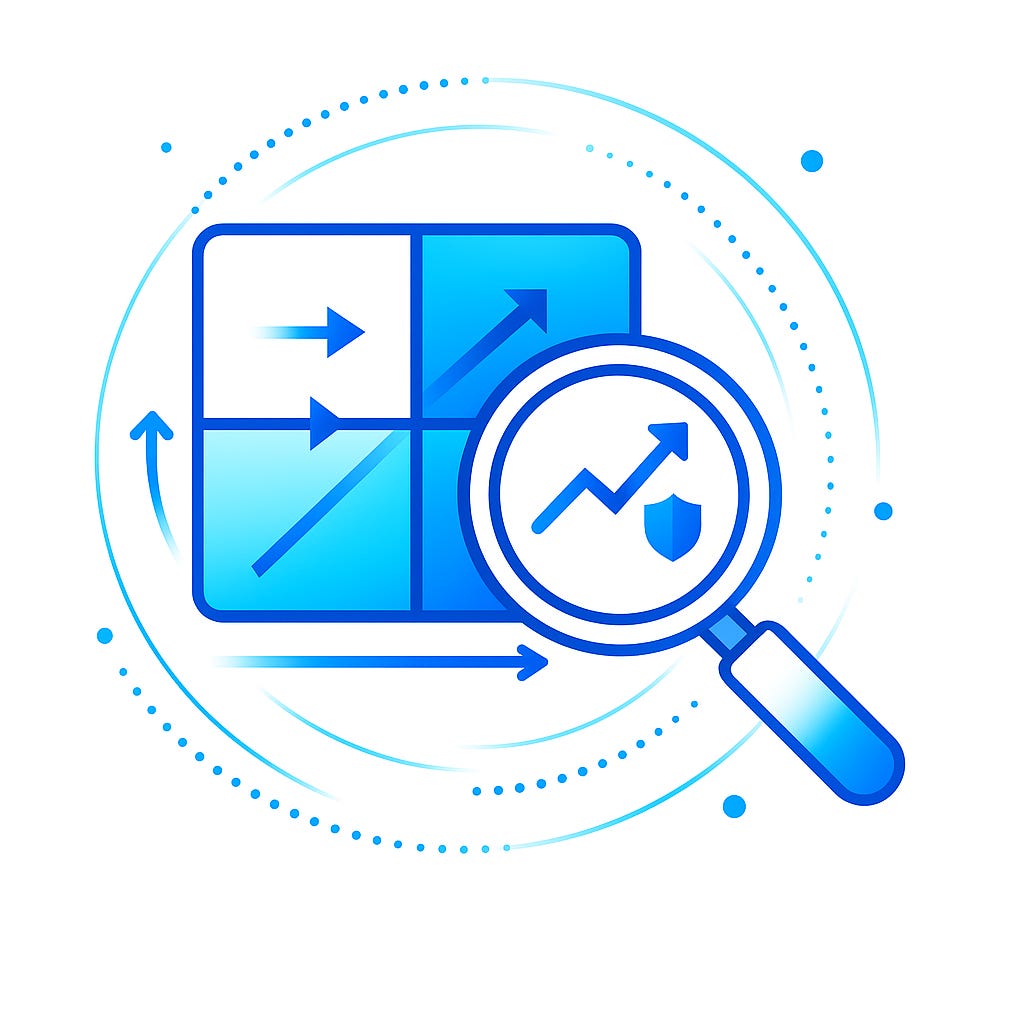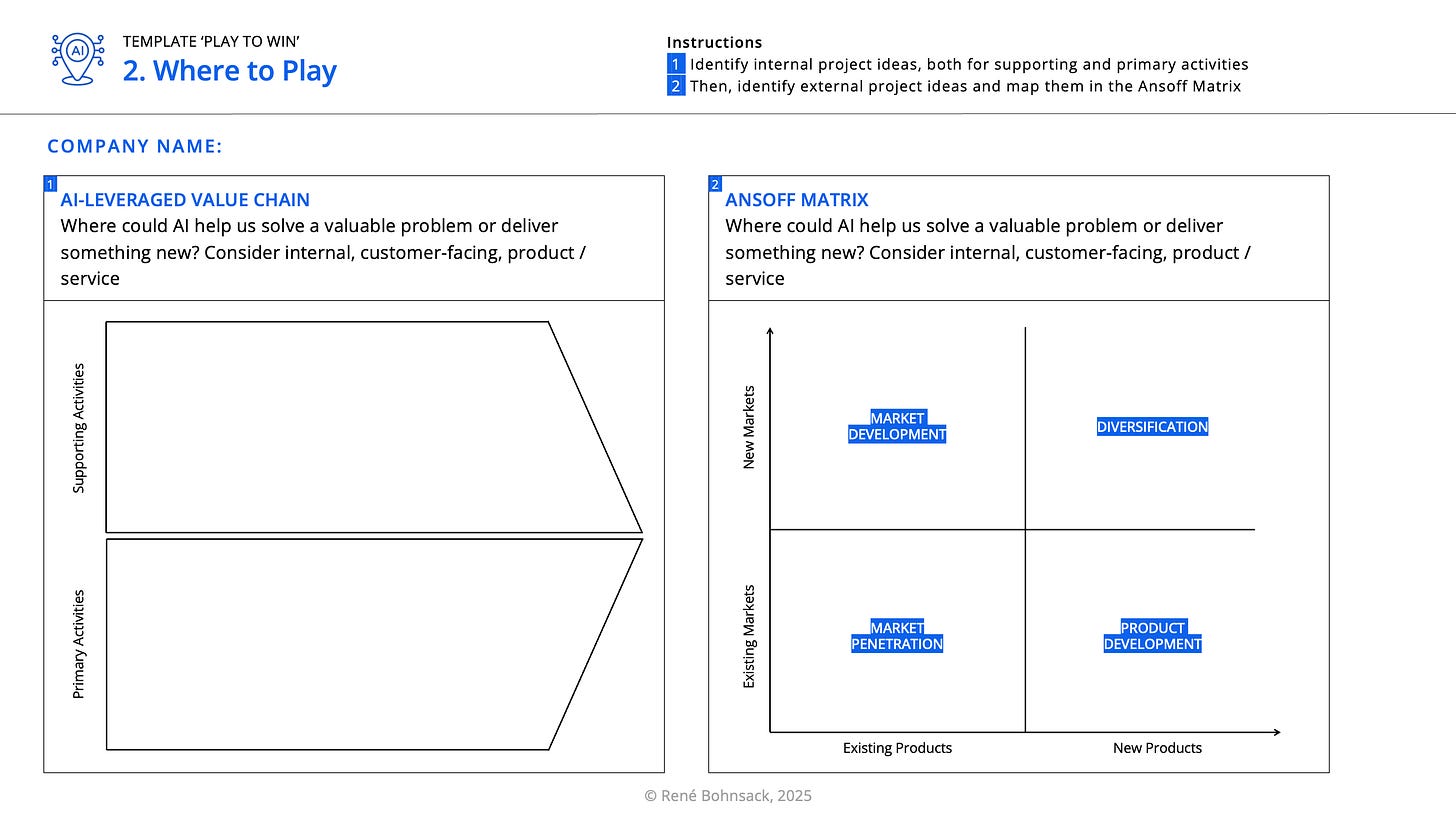Where to Play (and Not to) - AI Strategy Starts with Focus, Not FOMO
Why choosing where (and where not) to play changes everything
TL;DR
Most companies try to do too much with AI and end up spreading their efforts too thin.
The second question in the Play to Win strategy framework is "Where will we play?"
Deciding where (and where not) to apply AI is critical to avoid diluted investments and disconnected use cases.
Use two strategic lenses: internal (value chain friction) and external (growth or defense opportunities).
Clear focus increases ROI, accelerates capability development, and sets up sustainable advantage.
In the first part of this series, we looked into how defining your AI Winning Aspiration sets the purpose behind your use of AI. It sharpens decision-making, filters noise, and aligns your organization toward a common outcome. Without it, any attempt to prioritize AI use cases becomes an exercise in guesswork. Without focus, even the best aspirations remain words on a slide.
In case you haven’t, you can read here the first part of the Play to Win 5-parts series.
Now, in this part, we will be exploring how to define the battlegrounds where AI will create meaningful value, and, equally importantly, where it won't.
The Problem with Playing Everywhere
When it comes to AI, many companies operate under the illusion that more equals better. More pilots. More departments experimenting. More use cases being explored.
The reality? Most organizations are doing too much. They pursue AI in HR, marketing, finance, legal, and customer service simultaneously, hoping that something will stick. What they end up with is a scattered portfolio of disconnected tools that stretch their resources and erode momentum.
Trying to do everything means doing nothing well. AI success requires prioritization, and prioritization begins with choosing where to play.
A Familiar Pattern
In one recent strategy workshop, I asked a room of business unit leaders to list all their current or planned AI initiatives. The results filled an entire wall. From GenAI-powered marketing copy to invoice scanning bots, from fraud detection models to internal knowledge assistants, each team had something in motion. And each initiative was progressing in isolation.
When we asked which of these would create the greatest value this year, the room went quiet. Everyone was doing something. But no one was doing something together. It was a classic case of activity without alignment. The organization had enthusiasm. It had budget. What it lacked was a shared point of focus.
Defining Where to Play
"Where to play" means defining the business domains, customer segments, use case families, or geographies where AI will create the most impact.
It doesn’t mean closing the door on other areas forever. It means choosing where to direct scarce time, attention, and resources now. Clarity here sets the foundation for strategic advantage.
Two lenses can help:
1. The Internal Lens: Analyze potential for AI based on Porter’s value chain
Michael Porter introduced the value chain to help businesses identify the specific activities through which they create value. It breaks down a company into its core functions, from inbound logistics to marketing and customer service, and reveals where competitive advantage can be built.
Today, this lens is highly relevant for AI because many AI use cases live in the process layer. The value chain shows us where AI can remove friction, reduce cost, enhance speed, or improve decision-making. It brings structure to identifying high-impact internal opportunities. A value chain analysis helps you spot those moments with clarity and precision.
Look at your core business processes. Where is work slow, repetitive, manual, or error-prone? Where are decisions delayed due to lack of data or insight?
Common internal friction points include:
Contract review
Customer onboarding
Procurement and supplier management
Call center interactions
Compliance reporting
AI can be applied to eliminate, augment, or accelerate these workflows, but only if you focus. Pick one domain and go deep before expanding.
2. The External Lens: Growth Opportunities
First published in 1957, the Ansoff Matrix remains one of the most practical tools for thinking about growth strategy. It asks: Are you trying to grow through existing products or new ones? In existing markets or new ones?
This becomes incredibly powerful when applied to AI. AI can help you penetrate existing markets, personalize offerings, scale into adjacent segments, or even launch new digital-first business models. The Ansoff Matrix gives structure to that ambition. Instead of jumping at AI ideas randomly, it helps leaders define whether they’re using AI to defend the core, optimize for growth, or enable innovation.
Look at your company and ask: Is our AI ambition about improving, expanding, innovating, or disrupting? It’s a powerful way to evaluate risk, alignment, and the strategic intent behind each use case. Consider:
Use AI to defend core offerings (e.g. automate renewals)
Use AI to grow in adjacent segments (e.g. serve smaller customers at lower cost)
Use AI to create entirely new value propositions (e.g. insights-as-a-service)
This lens forces strategic conversation: Are we protecting the base, or inventing the next horizon?
Combined, these two lenses, internal (value chain) and external (Ansoff Matrix), help you make clear, strategic choices about where to play with AI. Not everywhere. Not all at once. But with intention.
Try This: Focus with Intention
If you're ready to sharpen your AI strategy, walk through this exercise:
1. Map the AI Value Chain (Internal Lens)
Where in your operations could AI create real advantage? Think customer service, logistics, R&D, marketing, finance, compliance. Mark areas of inefficiency or opportunity.
2. Apply the AI Ansoff Matrix (External Lens)
Where could AI help us solve a valuable problem or deliver something new? How can AI help you:
Penetrate existing markets?
Develop new markets?
Create new offerings?
Defend your current position?
3. Evaluate Fit
Where do you already have strengths, in data, talent, customer insight, or infrastructure, that could give you an edge with AI? Filter ideas that are both high-impact and realistically executable.
4. Make Focused, Exclusionary Choices
Choose one or two strategic domains to prioritize. Equally important: make a conscious decision about where not to play, for now.
Focus isn’t about saying no forever. It’s about sequencing smartly. A few guidelines:
Customer Clarity: External ideas often lack definition of the target customer or value proposition. Sharpen the market insight.
Link Internal to External: Internal capabilities (like AIOps or chatbots) should be positioned as future offerings, not just internal efficiencies.
Time-Phased Execution: Consider sequencing of initiatives, starting with quick wins, then scaling to platform and ecosystem impact.
Why It Matters
Where you choose to play with AI sets off a chain reaction. It influences which capabilities you need to build, determines which systems must be upgraded or rethought, and it shapes how quickly you’ll get to value.
A focused strategy creates momentum. It lets you build early wins, deepen expertise, and build a flywheel of adoption. Instead of five disconnected pilots, you get one successful deployment that becomes a case study for others to follow. Focus also supports governance. It’s easier to measure results, manage risks, and learn what works when you’re not chasing everything at once.
The best AI strategies are sequenced. They don’t start everywhere. They start somewhere smart.
One Company’s Pivot to Focus
A mid-sized services firm I advised had nine AI pilots running at once. Everything from scheduling optimization to content tagging to email response bots. Progress was slow across the board.
After an internal strategy reset, the leadership team made a bold decision: pause or sunset everything except a single use case, a predictive model to triage incoming service tickets. They built a cross-functional team around it. Focused on just that one problem for 90 days. Deployed. Measured. Improved.
The result? Average ticket resolution time dropped by 35%. Customer satisfaction scores rose. The team that built the model became internal champions. And other units asked to learn from their approach.
The company didn’t lose momentum by focusing. It gained it.
Where Should You Play?
Look at your AI ambition and current efforts. Are they focused or fragmented? Are you chasing visibility, or solving for impact?
Ask yourself:
Where is friction costing us time, money, or talent?
Where could we build a clear advantage with AI?
What use case, if solved, would create a success story others can follow?
Choose one area. Make it matter. Let success there light the path forward.
In the next issue, we’ll move to the third question in the Play to Win framework: How will we win? We’ll explore how to move from use cases to competitive advantage, and why simply adopting AI isn’t enough.
Until then, ask yourself: Where will you play, and where will you deliberately choose not to?
Warmly,
René Bohnsack








